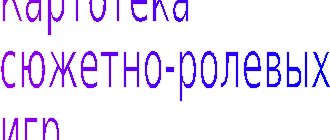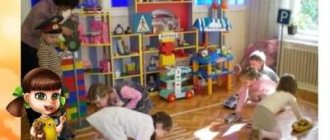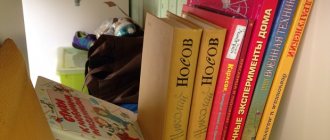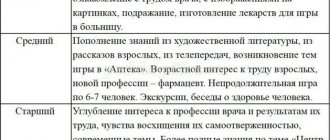Summary of the plot-role-playing game in the preparatory group
Summary of the role-playing game “Journey to the Mysterious Island” in the preparatory group
Author. Makarova Nadezhda Leonidovna, teacher of the MDOU combined type kindergarten No. 30 Kipen, Leningrad region. Description. I offer a summary of the role-playing game “Journey to the Mysterious Island” for children in the preparatory group. This work will be of interest to teachers of preschool institutions who work with children of this age category. The relevance of conducting role-playing games. Role-playing games allow you to develop children's creative abilities and their imagination. In the game, children learn to get used to the image of a particular character and play a certain role. They are of great importance in the social adaptation of the child and the realization of his potential in the future. In the role-playing game, the child’s personality, his intelligence, will, imagination and sociability are successfully developed, but most importantly, the role-playing game generates the desire for self-realization and self-expression. Target. To develop in children the ability to combine various thematic plots into a single game plot; establish and regulate contacts in a joint game. Tasks. 1. Expand the range of children's games, teach them to play together (discuss the plot, come up with new roles and game actions), help create a game environment taking into account the theme of the game and an imaginary situation, teach them to name their role, verbally determine the events depicted, the location of the players (here is the sea , this is a ship, it is sailing to a mysterious island, etc.). 2. Reinforce in children the sequence of days of the week, the number and order of counting, the names of geometric shapes, measuring objects using a conventional measure, and orientation in space. 3. Activate children's vocabulary: cabin, navigator, boatswain, porthole, cook, travel agency, courier, cruise. 4.Develop creative thinking, imagination, and fantasy in children. 5. Cultivate friendly relationships and a sense of teamwork in children. Preliminary work. Examination of photographs, illustrations, pictures depicting various ships. Construction of ships from various building materials and paper. Reading “Native Man” by V. Korzhikov, “Shark” by L. N. Tolstoy. Making attributes for the game. Watching the cartoon "Boniface's Vacation." Conversation after watching the cartoon. Writing stories on the topic: “What if I went on a trip.” Game attributes. Modules for building a ship, seven multi-colored (according to the colors of the rainbow) flags, caps, binoculars, an anchor, small toys from Kinder surprises, a conventional measure - braid, napkins, wallets, money, tickets, a computer, bananas, a cutting board.
Progress of the game.
Educator.
Children, let's play with you.
What game do you want to play? (Children's answers). Educator.
Okay, we're going on a sea cruise!
What will we sail on? (Children offer different options - choose a ship). Educator.
Guys, what day of the week do you think is best to travel?
Why? What is the day of the week called today? (Children's answers). Let's not delay our voyage! Let's go traveling today! Educator.
Let's think about where we're going? (Children's answers. I offer the children seven multi-colored (according to the colors of the rainbow) flags, on one side of each flag a letter is written.) Guys, if you arrange the flags by color in the same order as a rainbow, then you will find out where we will go on the cruise. (Children complete the task and read the word “islands”). Yes, to the islands!
Together with the children, we decide what we need to prepare for the trip and assign roles. We choose an agent to work in a travel agency, a courier to purchase vouchers, a supermarket seller, a supply manager to purchase the necessary goods for the cruise (a set of small toys, wet wipes, four knives). The rest of the children are ship designers (we build the ship from modules). When everything is ready for the trip (tickets have been purchased, goods have been purchased, and most importantly, the ship has been built), the children choose a captain, a navigator, and a cook. The rest of the children will be sailors. Boarding of the ship is announced. The captain checks the tickets, it turns out that the tickets were bought from a travel agency to the “Mysterious Island”. Everyone takes their places on the ship. The captain gives the command to the navigator. The ship departs from the pier (a recording of the sound of the sea and a ship signal sounds). During the journey, children play with their tickets. The tickets are unusual, with tasks. On one side of the ticket you need to count the number of objects, and on the reverse side you need to find the differences in the picture depicting two ships.
So the ship approaches its destination unnoticed, but a problematic situation arises.
There is no ship pier on this island. Educator.
Children, how can you get to the island?
(Children's answers). The captain suggests getting to land using a life preserver. Children imitate swimming with a lifebuoy to the song “Chunga-Changa” by V. Ya. Shainsky and land on the island. On the island we listen to birdsong (a recording of bird voices sounds). Next, the children try to imagine what can grow here, how beautiful it is here. Educator.
Children, it is very hot on the island, you can take off your shoes and walk barefoot on the sand.
(At this time, small toys from Kinder surprises that the children wanted to play with accidentally fell apart.) How can you collect the toys? (Children's answers). Yes, of course, now you and I will turn into monkeys and collect toys with our toes. (Children collect toys with their toes and put them in a basin.) Educator.
Who do you think lives on the island? (Children's answers). We put together a cut-out picture and find out what kind of funny people live here.
Educator.
Children, how can you imagine what kind of home they might have? What might their house be called? (Children's answers). We will now come up with a home for them using these pictures. (The game “Wonderful Things” (TRIZ) is being played. This game can be found in the book “Amazing Stories” by L. E. Belousova. The house is green, made of rubber, four-story, moves on chicken legs, a guitar is always playing in it, the smell of strawberries in the house. We discuss with the children whether it is comfortable to live in such a house. The game “Good - Bad” (TRIZ) is played.)
Educator.
Children, if this island is mysterious, there must be treasures here?
(The game is played: “Find the treasure.” Three children are blindfolded. According to the specified plan, they look for treasures. The plan is voiced by the captain. The children quickly find the treasure, but they cannot open it without guessing the following spell (a recording from a tape recorder sounds): “There are two objects - one of them grows here on the island, the other is in your group and in the music room. Both of these objects begin with one sound and end with a sound, but another. Each word has five sounds. Children guess the word "banana" and the word “tambourine.” A treasure opens (a beautiful antique chest prepared in advance), and there are bananas.) Educator.
Guys, we are on an unusual island, it’s so mysterious, and it’s hot here. Maybe we can turn these bananas into ice cream? (The children happily agree.) Then let's wash our hands first. (A finger game is played. “Wash your big finger, wash your index finger, wash your middle finger, ring finger and small little little finger.” Children wash their fingers using wet wipes. The cook distributes bananas. The children are faced with a problematic situation - there are not enough bananas for everyone. What to do? Children using a conventional measure (braid), divide the bananas in half, then cut, peel, insert an ice cream stick on one side of the banana and roll the banana in cocoa.You get ice cream and everyone treats themselves.
Educator.
Guys, let's take a look at the magic chest where the bananas were. (The children look into the chest, it turns out to have a second bottom. There the children find souvenirs from the inhabitants of the island - jewelry with a shell.) The journey comes to an end. We have to go back to kindergarten. Children close their eyes and say the magic words: “One, two, three, four, five - we are in kindergarten again.” And they end up in a group. They look at their jewelry and plan to go to the mysterious island again, so that next time they can get acquainted with the marine inhabitants of the island.
We recommend watching:
Summary of the plot-role-playing game for children 3-4 years old Summary of open intellectual and physical education leisure in the preparatory group Synopsis of the plot-role-playing game “Zoo” in the middle group Game leisure based on Pushkin’s fairy tales in the preparatory group of the kindergarten
Similar articles:
Summary of a lesson in the preparatory group on the topic: Spring
Playful musical entertainment for children of the preparatory group in kindergarten. Scenario
Spring leisure in the preparatory group. Semik - Russian rite of flowering
Fun in the preparatory group. Russian customs
Fun game for children in the preparatory group of kindergarten
Didactic game on cognitive development for children of the preparatory group of preschool educational institutions
Summary of the game “What will be what?”
for children of the preparatory group for school Author: Likhovidova Sofya Mikhailovna. Position, place of work: student at Veshensky Pedagogical College named after. M.A. Sholokhov", specialty "Preschool education", Rostov region, Sholokhovsky district, Veshenskaya village. Description of the material: a summary of the game has been prepared for children in the preparatory school group. The didactic game is aimed at developing the cognitive interests of children (OO Cognitive Development). This summary may be of interest to both teachers of preschool educational organizations and students studying in the specialty “Preschool Education”. Group: preparatory. Goal: formation of cognitive actions. Didactic tasks: improve the ability to establish simple connections between subjects; continue to promote the development of the ability to think logically and answer questions in complete sentences; practice naming objects correctly. Developmental objectives: to promote the activation of children's speech; promote the development of memory, attention, thinking. Educational objectives: create conditions for nurturing independence, friendly relations in the group, respect for each other. Game task: answer what will be and what was. Game rules: catch the ball, answer the question, do not shout. Game actions: line up in a circle, catch the ball, answer a question. Equipment: ball, Dunno. Preliminary work: looking at illustrations, talking with children, watching videos, observing while walking.
Progress of the game
Educator: Hello, guys! My name is Sofya Mikhailovna. I am glad to see you all cheerful and healthy. Guys, do you know who I met near the gate of your kindergarten? I met Dunno (a crying Dunno enters the group)
.
Guys, let's ask him why he's crying? Children: Let's go. Educator: Dunno, answer us, why are you so sad? Dunno: I really like to play different games, but I can’t do a lot of things. That's why no one wants to play with me. Educator: Dunno, what game is causing you difficulties? Dunno: I can’t always answer the question in the game “What will be what?” Educator: Guys, can we help Dunno? Shall we play his favorite game with him? Children: Yes. Educator: Then for this we’ll take a ball. Dunno, stand in a circle with the guys. I will throw a ball to each of you and say a word, and you will have to answer what comes of it. Well, for example: an egg can produce a chicken, a bud can produce a leaf, and so on. The one with the ball in his hands answers; the others do not shout out. Guys, do you understand everything? Children: Yes. Educator: Dunno, if you find it difficult to answer, we will help you all together. Dunno: Okay! Educator: So, let's begin: Calf - cow Foal - horse Acorn - oak Caterpillar - butterfly Flour - dough / bread Chick - bird Lamb - sheep Leather - shoe Fabric - dress Board - closet Child - adult Educator: Well done, guys ! How much new things our Dunno will learn. Now let's do the opposite: I will say the word, and you will name what it used to be. For example: The table used to be a board, or the frog was a tadpole. Guys, do you understand everything? Children: Yes Teacher: Okay, let's continue: Dog - puppy House - brick Man - boy Mittens - wool Fish - egg Cat - kitten Plant - seed Goat - kid Paper - wood Glass - sand Pig - piglet Teacher: Guys, what a great job you are! Now our Dunno can play this game with his friends, because he has learned so many new things. Dunno: Yes, guys, thank you very much! Thanks to you, I have become smarter! And now, I ran to my friends. Goodbye! (Dunno leaves)
.
Children: Goodbye. Educator: Guys, what new game did you learn today? What is it called? Children: “What will happen?” Educator: Let's remember what paper used to be? What was glass? Well done guys, you worked really hard today. Dunno was very pleased!
We recommend watching:
Didactic game for kindergarten. Preparatory group Didactic games for the preparatory group of kindergarten Didactic games for children 6-8 years old Didactic game for speech development for children in the preparatory group
Similar articles:
Didactic games to familiarize yourself with flora and fauna for children of the senior preparatory group





